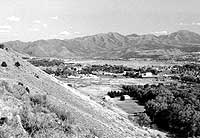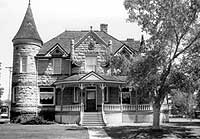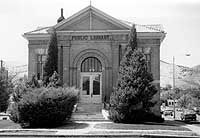|
Page
127
|

|
||
 |
||
| Mountain View Cemetery and the Bannock Range from Red Hill. At the foot of the hill, the Fort Hall Canal until the mid-1980s provided cool relief for joggers and their dogs. Progress dictated that the water be put underground. In the distance, from south to north, are Scout Mountain, Indian Peak, and Portneuf Narrows, the Gateway to the Pacific Northwest, (July, 1992). |
The
Fort Hall Canal
In 1907, Idaho Senator
Fred T. Dubois, who had risen to power by advocating and exploiting anti-Mormon
laws of the 1880s, helped negotiate the building of the Fort Hall Canal, which
would provide water by May, 1911, to 14,000 acres of Indian land and 12,000
acres of land ceded to whites. The canal ran along Hiline road, through the
east side of Pocatello, along the alley between 5th and 6th Avenues, across
the Idaho State University campus and behind Mountain View Cemetery. It is an
interesting geographic fact that this water comes from the Blackfoot River rather
than from Ross Fork or the Portneuf.
Frank
Paradice
Frank C. Paradice,
Jr. was Pocatello's foremost architect in the first half of the 20th century.
Paradice designed or redesigned most of the buildings in downtown Pocatello
between 1913 and 1952. These include the Valentine Building (former First Security
Bank), Fargo Building (Station Square), Central Building (Harrison's Jewelers),
the Old Federal Building (Dudley's), and Pocatello High School. Paradice was
a master of the Art Deco and Neoclassical Revival styles.
 |
| The Standrod House, north Garfield Ave., (June, 1992). |
The
Standrod House
A majestic house
on the west side of Pocatello is on the National Register of Historic Places.
Built in classical revival style, the two-story, turreted castle cost around
$12,000 to build in 1902, at a time when a dollar was a dollar. The 16 room
structure is faced with stone which was quarried in the McCammon area. After
a period of little use, the City of Pocatello acquired the house in 1974 and
it was available to rent for special events until 1995. Because it was not handicapped-accessible
it was sold in 1995, and is presently occupied by the Backroom furniture store.
The Standrod House was built by Judge D.W. Standrod. Standrod was born in Kentucky in 1858, and lived first in Idaho in Malad City where he was associated with banks. He was a member of the drafting committee for the Idaho Constitutional Convention in 1889. While he ran for several political positions, he was never elected (he was a Republican from a Democratic city). He was, however, a power in Republican politics in eastern Idaho. He served as a district judge in Pocatello.
The Standrod family was prominent in civic and cultural affairs. Mrs. Standrod was active in women's clubs. A daughter who was active in school activities and a leader of her class died at 16, to the great distress of the family. A son, Drew Standrod, Jr., lived in Pocatello for many years and died in 1937. A veteran of World War I, he was a well-known attorney, was musical and a leader in community cultural activities.
The judge died in 1942. The castle passed to his wife, who died in 1946, and the house passed to Drew Jr.'s wife who lived in it for a few years, then moved to the east, boarding up the house. It was sold in 1957 to Mrs. Madelyne Roper who lived in it until she sold it to the city.
 |
| Carnegie Library, Garfield Ave. and Center St., (June, 1992). |
The
Carnegie Library
In the early 1900s,
steel industrialist Andrew Carnegie began a program to encourage education by
financing community libraries across the United States. Carnagie was an immigrant
from Scotland who had little education but who realized the importance of education,
especially for the stream of immigrants who lacked sufficient education to compete
in the American job market. His public program furnished libraries for thousands
of communities across the country.
Many towns in Idaho have such libraries. The one in Pocatello, at the corner of West Center and South Garfield, was completed in 1907 at a cost of $12,000.The two story structure was larger inside than it appears but the library service outgrew the building prior to World War II. It was not until the 1950s that the city could construct a larger building on East Clark Street to replace the cramped Carnegie facility. In 1994 a new, larger Marshall Public Library was built on the original site, attached to the original Carnegie Library. The Bannock County Historical Museum occupied the old library building until its grand new home in Ross Park was completed in 1990.
The initial Carnegie Library was a city service, administered by an appointed library board and full salaried librarian. The first board chairman was Judge F.S. Dietrich. Dr. Minnie Howard, prominent Pocatello physician, historian and women's rights advocate, who lived just next door to the structure, where the new library now stands, also was a member of the first board.
In the 1910s a matching structure was erected across from the library on the east side of South Garfield as a Methodist Church. It, too, was outgrown and was replaced in the late 1950s by the present church at the corner of North 15th and East Clark. The original structure no longer exists.